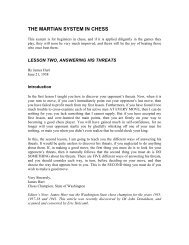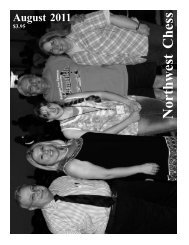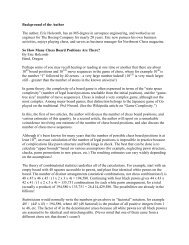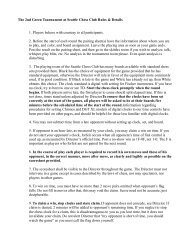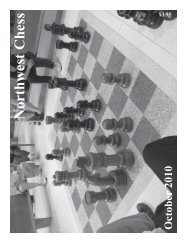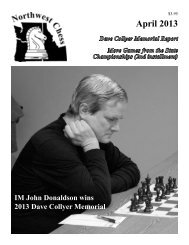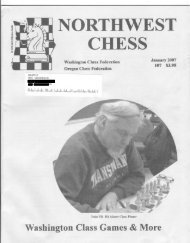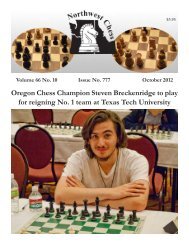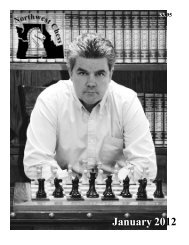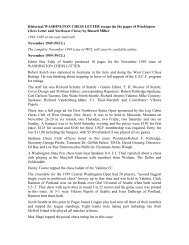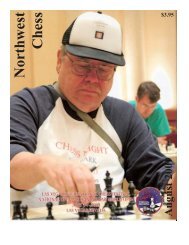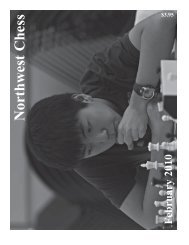April 2009
April 2009
April 2009
Create successful ePaper yourself
Turn your PDF publications into a flip-book with our unique Google optimized e-Paper software.
Curt Collyer - John Donaldson<br />
Dave Collyer Memorial, Round 4<br />
Spokane, Washington, March <strong>2009</strong><br />
1. Nf3<br />
After the game, Donaldson said he had<br />
expected me to allow the Nimzo-Indian, and<br />
had spent a good deal of time preparing that<br />
opening, so my first move came as a<br />
surprise.<br />
1. …Nf6 2. e3<br />
Due to my opponent’s greater opening<br />
knowledge, my strategy was to aim for a<br />
solid, but slightly offbeat position, where we<br />
would be on more equal footing.<br />
2. …g6 3. d4 Bg7 4. c4 O-O 5. Be2 c5<br />
Trying to sharpen things up. Because<br />
Donaldson had already drawn his third<br />
round game with Daniel Gay, it was<br />
important for him to win this game in order<br />
to stay in the hunt for first place.<br />
6. Nc3<br />
Now the position is like an English<br />
opening, with colors reversed. During the<br />
game I spent some time trying to find the<br />
best way to utilize my “extra” move.<br />
So now we are back to the Tarrasch<br />
positions, except with a pair of knights<br />
exchanged; I don’t think it’s clear whom this<br />
detail favors.<br />
10. Bf4 dxc4 11. Bxc4 Ne8<br />
During post-game analysis, Donaldson<br />
felt this knight maneuver was probably<br />
Black’s only good plan.<br />
12. Be5 Nd6 13. Bb3 Nf5 14. Bxg7<br />
Kxg7<br />
Perhaps Black should trade knights here<br />
to seek equality, although in that case the<br />
position would be more sterile.<br />
21. …Qb6 22. Ng3!<br />
During the game, I felt this was a strong<br />
move because it brings another piece to the<br />
kingside, while opening up the file for the<br />
rooks. I think possibly Black missed this<br />
when he declined to trade knights. Now it is<br />
not so clear what to do about the weak e-<br />
pawn.<br />
22. …Bg4!<br />
22... Nc4 23. Qg5! looked interesting.<br />
For example, 23. …Nxb2 24. Nh5+ Kg8 25.<br />
Qh6+-<br />
23. Rxe7<br />
Essentially calling Black’s bluff.<br />
23. …Rxe7 24. Rxe7 Qc5<br />
6. …cxd4 7. Nxd4<br />
7. exd4 d5 would be a reversed Tarrasch<br />
Defense, but the white [black] knight is not<br />
yet developed. Thus a variation like 8. c5<br />
b6 9. b4 a5 10. b5 is not coming with a gain<br />
of tempo against Nc6. I think Donaldson<br />
later mentioned that 8. h3 might be a good<br />
idea, however.<br />
7... Nc6 8. O-O Nxd4 9. exd4<br />
I considered 9. Qxd4 but thought<br />
variations like 9. …d6 10. b3 Ne4 11. Qxe4<br />
Bxc3 12. Rb1 Bf5 looked irritating.<br />
9... d5<br />
15. d5!<br />
This isolated pawn is fairly strong as it<br />
now cramps Black’s e-pawn. White now<br />
has the plan of pressuring down the e-file.<br />
15. …Bd7 16. Re1 Re8 17. Qd2 a5 18.<br />
Bc2 Nd6 19. Re2<br />
Here I thought White was probably<br />
slightly better, although in positions with an<br />
isolani, the evaluation can flip for either side<br />
with just one inaccuracy.<br />
19. …b5 20. Rae1 Rc8 21. Ne4<br />
White’s pieces are momentarily<br />
awkward, and Black has the initiative,<br />
however I’d foreseen an interesting idea<br />
here.<br />
25. h3!<br />
<strong>April</strong> <strong>2009</strong> Northwest Chess Page 7



